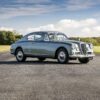Debuting at the 1953 Turin Motor Show, Lancia’s compact marvel, the Appia, shared styling cues with its larger Aurelia B10 sibling. Spearheading Lancia’s post-war innovations, the Appia bore the mark of renowned engineer Vittorio Jano, formerly of Alfa Romeo, who joined Lancia’s ranks in 1937.
At the heart of the Appia lay an ingeniously designed narrow-angle (10 degrees) 1,089cc V4 engine. Crafted with precision, this engine boasted inclined overhead valves nestled within hemispherical combustion chambers, orchestrated by twin block-mounted camshafts. Continuously pushing boundaries, Lancia maintained its unitary chassis construction and sliding-pillar independent front suspension, reminiscent of the pre-war Aprilia.
The Series I Appias, echoing the grandeur of the Aurelia, sported aluminum doors, wings, and bumpers, with a unique door configuration: front doors hinged forwards, rear doors aft, omitting a central pillar. Subsequent Series II (1956-1959) and III models saw enhancements, including a lengthened wheelbase and increased power output, reaching up to 48bhp.
Despite its engineering excellence, the Appia faced challenges in profitability due to its positioning in a fiercely competitive market. However, it found niche success with limited edition models, such as Pinin Farina’s coupé, Vignale’s cabriolet, and Zagato’s GT coupé, boasting enhanced power and aerodynamic prowess, reaching speeds of up to 100mph (160km/h).
Photos by Simon Clay courtesy of RM Sotheby’s
















